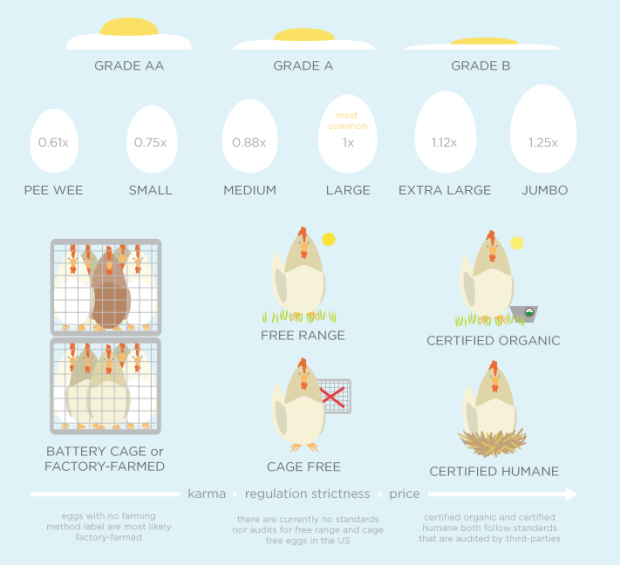I can’t resist. It’s about food and those chickens are just so cute. View the full guide to eggs on culinaut.
A visual guide to eggs


I can’t resist. It’s about food and those chickens are just so cute. View the full guide to eggs on culinaut.
What’s the unit of measure on the egg size?
Also if you really want a discussion of the meanings of organic (not cage free or free range), free range, and cage free (meaningless), check out the Cornucopia Institute’s report Scrambled Eggs. http://www.cornucopia.org/2010/09/organic-egg-report-and-scorecard/
No units for the eggs – just the relative sizes compared to that of the Large.
Wikipedia has a good breakdown of egg mass by size for various countries here (I used the US data for the graphic): http://en.wikipedia.org/wiki/Chicken_egg_sizes. I ended up focusing more on relative size as compared to a large egg (medium = .88 of a large egg) in the guide because most US recipes use large eggs as a standard, so relative sizing helps with substitutions.
Thanks for the link to the Cornucopia Institute’s report – that looks like a great resource!
How do they know they are Grade A if they have to cook them sunny side up to tell?
The same way they test for quality in other manufactured items: statistical sampling. Since the Grade is an indicator of freshness and other environmental conditions, they can crack open a few and deduce that the rest are similar.
Shouldn’t the top row be listed Grade B, A, AA , in that order? Then it would be consistent with the price of the egg, as the other rows are.
With regards to your question, you’re right – that order would be consistent with price. When I made the graphic, I meant for the arrow under the farming methods to refer to just the farming methods, and not the sizes and grades. I now see how that can be a little confusing and I’ll see if I can make it more clear in V2. Thanks for pointing it out!
An updated version of the infographic which works in feedback from the original one is available here: http://culinaut.blogspot.com/2011/03/visual-guide-to-eggs-v2.html